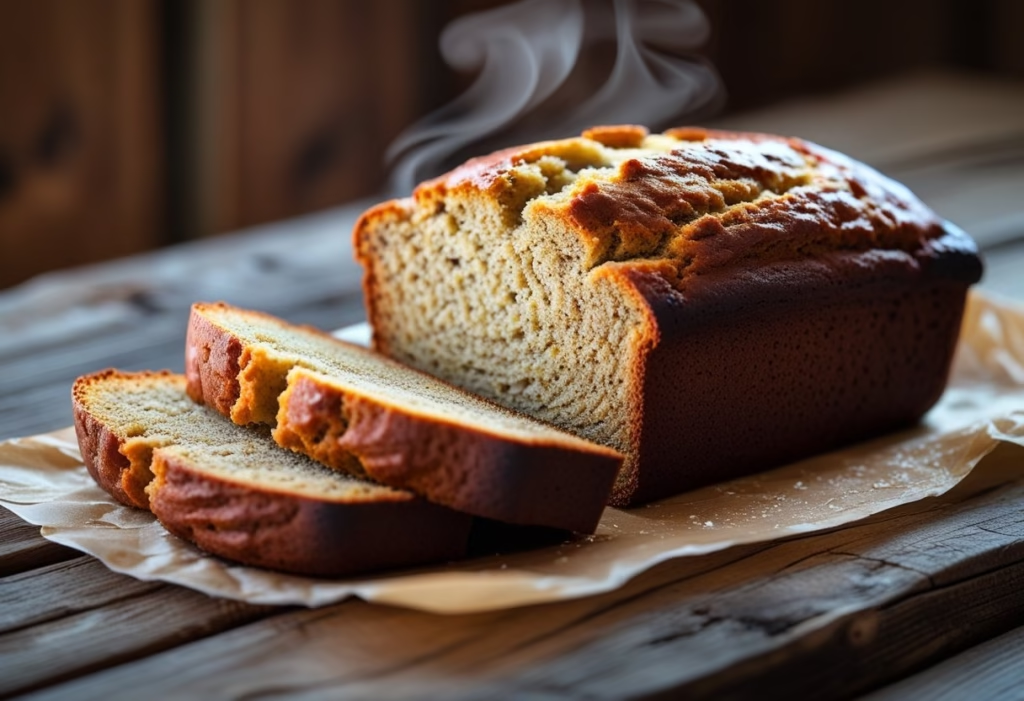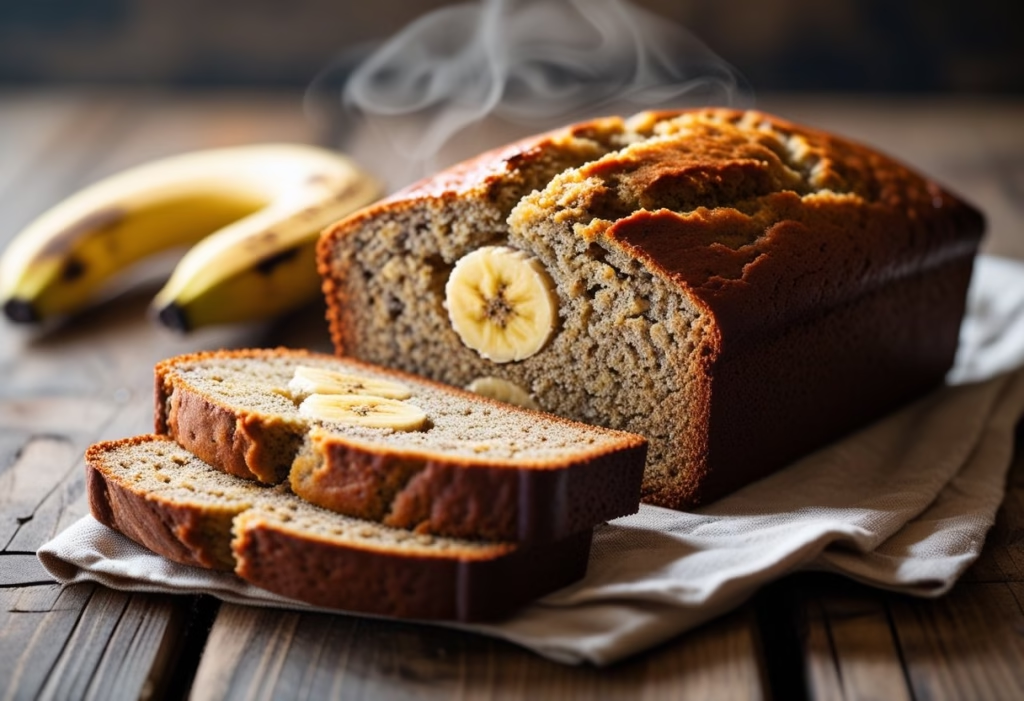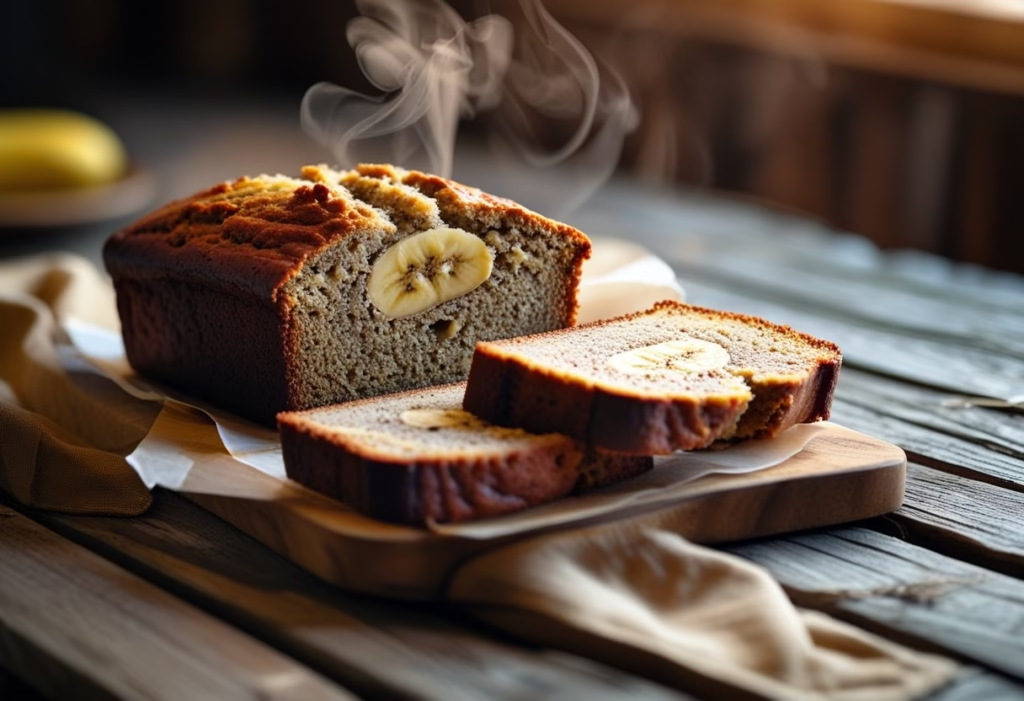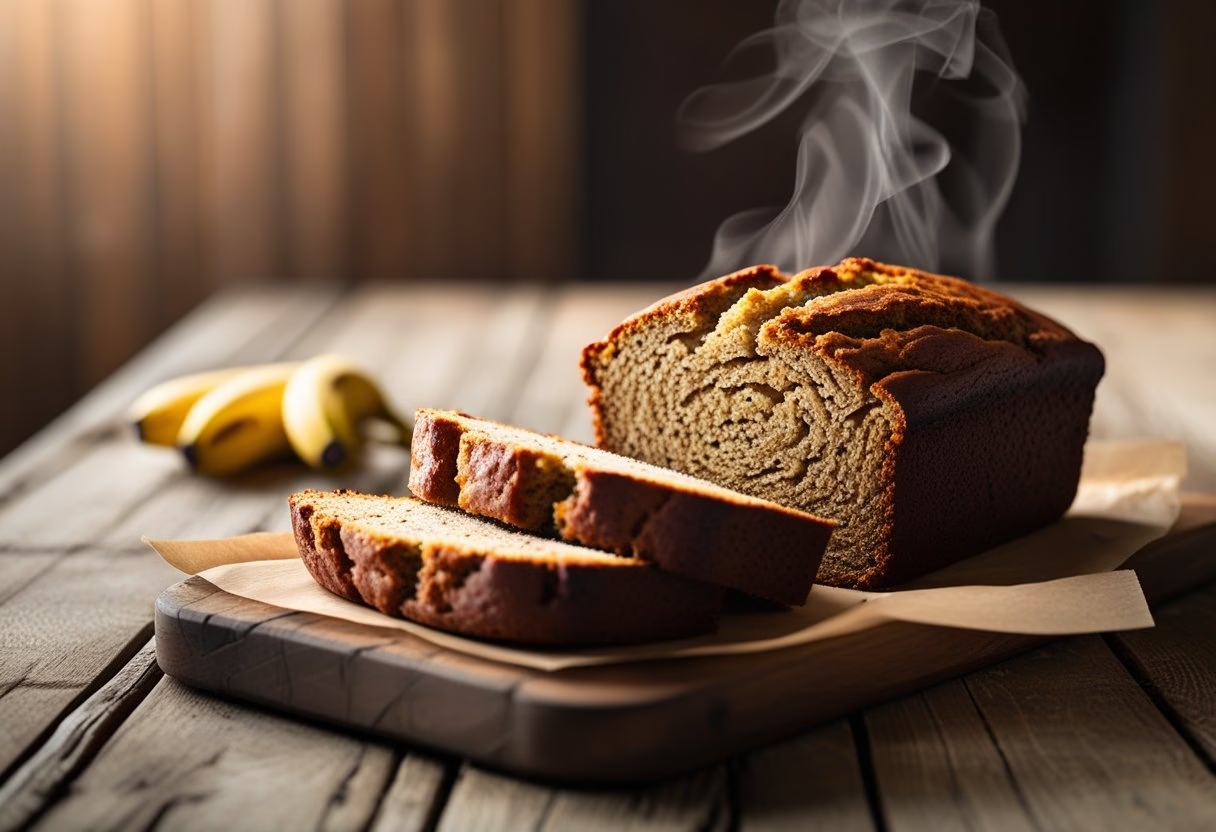Banana bread is a popular baked good that uses ripe bananas, flour, sugar, eggs, and baking soda as its core ingredients. The recipe is straightforward: combine the mashed bananas with dry and wet ingredients, mix until smooth, and bake at a moderate temperature until golden brown.
This recipe balances the natural sweetness of bananas with a tender, moist texture. It requires only basic kitchen tools and ingredients that are often on hand, making it accessible to both beginners and experienced bakers.
Understanding the key ingredients and preparation steps ensures consistent results every time. Following the simple method outlined will help achieve a classic banana bread with minimal effort.

Essential Banana Bread Recipe Ingredients
Banana bread requires specific ingredients that affect its texture, flavor, and rise. The quality and ripeness of bananas are critical for the right sweetness and moisture. Additional optional ingredients can modify taste and nutrition without compromising the basic recipe.
Key Ingredients for Classic Banana Bread
The core ingredients include ripe bananas, all-purpose flour, sugar, eggs, butter, baking soda, and salt. Ripe bananas provide natural sweetness and moisture.
Typical ingredient amounts:
- 3 to 4 mashed bananas
- 1 ½ to 2 cups flour
- ¾ to 1 cup sugar
- 2 eggs
- ⅓ to ½ cup melted butter
- 1 teaspoon baking soda
- ½ teaspoon salt
Baking soda acts as a leavening agent, helping the bread rise and stay light. Salt balances the sweetness and enhances flavor. Some recipes use baking powder but baking soda is preferred with acidic bananas.
Choosing the Best Bananas
Overripe bananas with brown spots are ideal for banana bread. They have a stronger banana flavor and high sugar content.
Firm, green bananas are too starchy and will not dissolve properly when mashed. If bananas are not ripe enough, leaving them at room temperature for several days will expedite ripening.
Freezing overly ripe bananas is possible and even improves softness when thawed, suitable for baking. Bananas slightly past the overripe stage can also be used without affecting taste.

Optional Add-Ins and Substitutions
Walnuts, pecans, or chocolate chips are common optional mix-ins, adding flavor and texture. Spices such as cinnamon or nutmeg can complement the banana flavor.
For dietary substitutions, whole wheat flour can replace all-purpose flour for a denser texture. Honey or maple syrup can substitute sugar, keeping sweetness natural.
Dairy-free versions replace butter with coconut oil or vegetable oil. Eggs can also be substituted with flaxseed meal mixed with water for a vegan alternative.
Preparation Steps for Banana Bread
The preparation involves breaking down ripe bananas for a smooth base, ensuring wet and dry ingredients are properly combined to maintain texture, and carefully mixing all components before baking. Precise execution of each step guarantees consistent moisture and even flavor distribution throughout the bread.
Mashing Bananas
Bananas should be very ripe, with brown spots, for optimal sweetness and softness. They are peeled and placed in a large bowl, then mashed using a fork or potato masher until mostly smooth with a few small lumps. Over-mashing can reduce texture variety, so moderate mashing is best.
If bananas are not ripe enough, the bread may lack sweetness and moisture. A good mash consistency resembles thick applesauce. Avoid liquid pooling by draining excess moisture if bananas seem overly wet, which can impact batter balance.
Mixing Wet and Dry Ingredients
Wet ingredients typically include mashed bananas, eggs, melted butter or oil, and vanilla extract. These are mixed in a separate bowl until smooth. Dry ingredients—flour, baking soda, salt, and sometimes spices like cinnamon—are sifted together to avoid clumps.
Combining wet ingredients first helps incorporate moisture evenly, while sifting dry ingredients ensures even leavening. It is important not to overmix once both are combined to avoid dense bread.
Combining and Pouring the Batter
Wet and dry mixtures are gently folded together using a spatula or wooden spoon. The key is to mix just until the flour disappears; overmixing activates gluten, which toughens the bread. Small chunks of banana can remain for texture.
Once combined, the batter is poured into a greased or parchment-lined loaf pan. Tapping the pan lightly on the counter removes air bubbles, providing even baking. The batter should be spread evenly before placing the pan in the oven.

Baking the Banana Bread
The baking process requires precise temperature control and preparation to ensure even cooking. Proper preparation of the pan and the right timing are essential to avoid undercooked or overly dry bread.
Preheating and Preparing the Pan
The oven should be preheated to 350°F (175°C) for consistent heat. This temperature allows the bread to cook evenly without burning the exterior.
Use either a standard 9×5-inch loaf pan or a similarly sized baking dish. Grease it lightly with butter or use non-stick spray. Alternatively, lining the pan with parchment paper prevents sticking and makes removal easier.
Ensure the pan is fully prepared before pouring in the batter. This prevents the bread from sticking and maintains its shape during baking.
Baking Time and Temperature
Bake the banana bread at a steady 350°F (175°C). The typical baking time is between 55 and 65 minutes.
Avoid opening the oven door during the first 45 minutes to maintain a stable temperature. This is crucial for proper rising and texture.
If the top browns too quickly, loosely cover the loaf with aluminum foil after about 40 minutes. This prevents overbaking the crust while the inside finishes baking.
Testing for Doneness
Check for doneness by inserting a toothpick or cake tester into the center. If it comes out clean or with just a few moist crumbs, the bread is done.
The bread should feel firm but springy when pressed gently in the middle. If it is still wobbly or mushy, return it to the oven for an additional 5 to 10 minutes.
Let the bread cool in the pan for 10-15 minutes before transferring it to a wire rack. This helps it finish setting and prevents breaking when removed.
Serving Suggestions
Banana bread pairs well with simple accompaniments that enhance its natural sweetness and moist texture. It is versatile enough to be enjoyed plain, toasted, or dressed up with a variety of toppings and spreads.
Best Ways to Serve Banana Bread
Banana bread is often served as a breakfast item or afternoon snack. Slices can be eaten warm or at room temperature. Toasting the bread slightly enhances its flavor and soft crumb.
It can be served alongside coffee, tea, or milk for a balanced snack. For a heartier option, it pairs well with scrambled eggs or yogurt. Small chunks or slices can be used in desserts like bread pudding or trifle.
Serving portion sizes typically range from one to two slices per person, depending on the occasion and hunger level.
Toppings and Spreads
Simple toppings like butter or cream cheese add creaminess without overpowering the banana flavor. Nut butters—such as almond or peanut butter—introduce protein and a richer taste.
Sweet spreads like honey, maple syrup, or fruit preserves complement banana bread well. For a more indulgent choice, a light drizzle of chocolate or caramel sauce can be added.
Fresh fruit slices, especially strawberries or blueberries, provide contrast and freshness. Nuts or seeds sprinkled on top add a .
Storing and Freezing Tips
Banana bread should be stored properly to maintain its freshness. Once cooled, wrap it tightly in plastic wrap or aluminum foil. This prevents the bread from drying out.
For short-term storage, keep the banana bread at room temperature. It will stay fresh for up to 2 days this way. Placing it in an airtight container also helps retain moisture.
To extend the shelf life, refrigerate banana bread. It can last up to 1 week in the fridge. Always ensure it is sealed well to avoid absorbing other odors.
Freezing banana bread is effective for long-term storage. Wrap the loaf or individual slices in plastic wrap, then place them in a freezer-safe bag or container. Label with the date to track freshness.
Frozen banana bread can last up to 3 months. To thaw, leave it at room temperature for a few hours or overnight. Reheat slices in a toaster or oven for a fresh taste.
| Storage Method | Duration | Tips |
|---|---|---|
| Room Temperature | Up to 2 days | Use airtight container |
| Refrigerator | Up to 1 week | Wrap tightly |
| Freezer | Up to 3 months | Double-wrap and label date |
Following these steps keeps banana bread moist and flavorful. Proper storage avoids waste and saves time on future baking.
Troubleshooting Common Issues
Several factors affect the texture and doneness of banana bread. Adjusting ingredient ratios and timing will help achieve the desired results.
Preventing Dense or Gummy Texture
Dense or gummy banana bread often results from using too much flour or overmixing the batter. It is important to measure flour correctly, preferably by spooning it into the measuring cup and leveling it off without packing.
Overmixing develops gluten, which leads to a heavy texture. Mixing the wet and dry ingredients just until combined helps maintain a light crumb.
Using overly ripe bananas can increase moisture, so slightly underripe bananas or draining excess banana liquid can improve texture. Additionally, including the right amount of baking powder or baking soda ensures sufficient rise and prevents density.
Avoiding Overbaking
Overbaking dries out banana bread and makes it tough. Baking times vary depending on oven calibration and pan size, so setting a timer close to the minimum suggested time is advisable.
Testing doneness with a toothpick or skewer inserted in the center will prevent overbaking. If it comes out with a few moist crumbs, the bread is done.
Covering the bread loosely with foil if browning too quickly yet not baked through will protect the crust while allowing the inside to finish baking evenly.
Nutritional Considerations
Banana bread typically contains carbohydrates, fats, and sugars, which contribute to its calorie content. The main source of carbohydrates comes from ripe bananas and added sugars or sweeteners.
The inclusion of eggs and butter adds protein and fat, including saturated fat. Adjusting these ingredients can impact the bread’s overall nutritional profile.
Fiber content depends largely on the bananas used and whether whole wheat or refined flour is chosen. Whole wheat flour increases fiber and can improve digestion.
| Nutrient | Approximate Amount (per slice) |
|---|---|
| Calories | 180-220 |
| Carbohydrates | 30-35 g |
| Protein | 3-5 g |
| Fat | 7-10 g |
| Fiber | 1-3 g |
| Sugar | 12-18 g |
Reducing sugar or using natural sweeteners can lower the sugar content. Substituting butter with oils or Greek yogurt can decrease saturated fat and increase moisture.
Portion size matters; a smaller slice reduces calorie intake without sacrificing flavor. Considering ingredient swaps allows for customization to fit dietary needs or preferences.
Creative Variations
Banana bread can be adapted in many ways to suit different tastes and dietary needs. Adding nuts such as walnuts or pecans introduces a crunchy texture and a richer flavor profile.
Incorporating spices like cinnamon or nutmeg gives the bread a warm, aromatic twist. Some prefer to use vanilla extract or even a splash of rum to deepen the taste.
For a healthier version, replacing some of the all-purpose flour with whole wheat flour or adding flaxseeds increases fiber content. Substituting sugar with natural sweeteners like honey or maple syrup can reduce refined sugar levels.
Fruit add-ins such as blueberries, chopped apples, or dried cranberries provide moisture and bursts of additional flavor. Chocolate lovers might add chocolate chips or a swirl of Nutella before baking.
A simple table of popular mix-ins might help:
| Ingredient | Effect | Suggestion Amount |
|---|---|---|
| Walnuts/Pecans | Crunch, nuttiness | ½ cup, chopped |
| Cinnamon/Nutmeg | Warm, spicy aroma | 1 tsp cinnamon |
| Blueberries | Moisture, fruity bursts | ½ cup, fresh/frozen |
| Chocolate chips | Sweet, rich flavor | ½ cup |
| Whole wheat flour | Higher fiber, denser bread | Replace ¼ of flour |
These variations allow each baker to tailor banana bread to personal preferences without changing the basic preparation method.
If you’re looking for more delicious salad recipes, don’t miss out on these tasty dishes: Easy Chicken Caesar Salad, Ultimate Dense Bean Salad Recipe, and Easy Chicken Salad Melt Recipe. Discover a wonderful mix of flavors and new ideas to create the best dishes in your kitchen!

